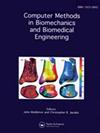通过机器学习研究高冲击和日常活动中ACL长度、应变和拉伸力。
IF 1.6
4区 医学
Q3 COMPUTER SCIENCE, INTERDISCIPLINARY APPLICATIONS
Computer Methods in Biomechanics and Biomedical Engineering
Pub Date : 2025-08-30
DOI:10.1080/10255842.2025.2551846
引用次数: 0
摘要
前交叉韧带(ACL)重建率正在上升,尤其是在女运动员中,尽管原因尚不清楚。本研究:(i)确定准确的机器学习模型,以预测六种高影响和日常活动中的ACL长度,应变和力;(ii)评估运动学和结构参数的重要性;(三)分析基于性别的伤害风险模式。每个变量使用9375个观测值,训练了42个模型。立体模型(Cubist)、广义提升模型(Generalized boosting Models, GBM)和随机森林模型(Random Forest, RF)获得了最好的R2、RMSE和MAE。膝关节屈曲和外旋强烈预测前交叉韧带拉伤和受力。女性运动员在割伤时旋转度更高,增加了前交叉韧带劳损和风险。本文章由计算机程序翻译,如有差异,请以英文原文为准。
Investigating ACL length, strain and tensile force in high impact and daily activities through machine learning.
Anterior cruciate ligament (ACL) reconstruction rates are rising, particularly among female athletes, though causes remain unclear. This study: (i) identify accurate machine learning models to predict ACL length, strain, and force during six high-impact and daily activities; (ii) assess the significance of kinematic and constitutional parameters; and (iii) analyse gender-based injury risk patterns. Using 9,375 observations per variable, 42 models were trained. Cubist, Generalized Boosted Models (GBM), and Random Forest (RF) achieved the best R2, RMSE, and MAE. Knee flexion and external rotation strongly predicted ACL strain and force. Female athletes showed higher rotation during cuts, elevating ACL strain and risk.
求助全文
通过发布文献求助,成功后即可免费获取论文全文。
去求助
来源期刊
CiteScore
4.10
自引率
6.20%
发文量
179
审稿时长
4-8 weeks
期刊介绍:
The primary aims of Computer Methods in Biomechanics and Biomedical Engineering are to provide a means of communicating the advances being made in the areas of biomechanics and biomedical engineering and to stimulate interest in the continually emerging computer based technologies which are being applied in these multidisciplinary subjects. Computer Methods in Biomechanics and Biomedical Engineering will also provide a focus for the importance of integrating the disciplines of engineering with medical technology and clinical expertise. Such integration will have a major impact on health care in the future.

 求助内容:
求助内容: 应助结果提醒方式:
应助结果提醒方式:


